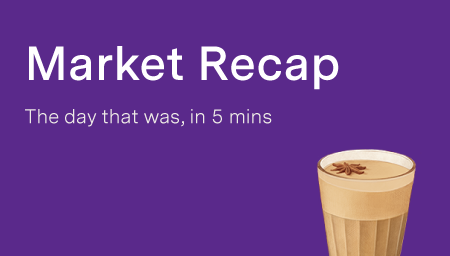Nifty50: 17,610 ▼ 5 (-0.03%)
Sensex: 59,932 ▲ 224 (+0.38%)
Namaste, friends!
Football fans across the world are accustomed to watching Lionel Messi dribble through a bunch of defenders to score goals or make assists. But now, this could be an elusive sight as the world cup winning Argentine has hinted at hanging his boots. On a podcast, the most coveted footballer player hinted at retirement, saying that he is very happy with closing his cycle.
Now, let’s move on to the markets, where the bulls seem to have temporarily retired. And the twins – Nifty and Sensex went separate ways again. 
- The markets witnessed sharp volatility
- Of the Nifty50 universe, 30 stocks declined
- The sell-off in Adani stocks continues to weigh down the markets
Among the Nifty sectoral indices, FMCG (+2.1%) and IT (+1.8%) were the top gainers, while Metal (-4.3%) and Oil & Gas (-1.9%) were the top losers.
| Top gainers | Today’s change |
| Britannia | 4,587 ▲ 216 (+4.9%) |
| ITC | 378 ▲ 17 (+4.8%) |
| IndusInd Bank | 1,080 ▲ 38 (+3.6%) |
| Top losers | Today’s change |
| Adani Enterprises | 1,565 ▼ 570 (-26.7%) |
| Adani Ports | 459 ▼ 35 (-7.2%) |
| UPL | 698 ▼ 43 (-5.8%) |
What’s trending
⭐ HDFC hits a home run
In the December quarter, the housing finance company’s (-1.7%) net profit rose by 13% YoY to ₹3,691 crore. The management said that the inherent demand for home loans continues to remain good. Meanwhile, bad loans also dropped to 1.4% of the loan book from 2.3% in the same quarter last year.
⭐ Titan misses street expectations
The owner and operator of Tanishq brand (-0.8%) posted net profit of ₹951 crore, down 4% YoY. The rise in employee benefit costs, advertising and other expenses dented the profit. Meanwhile, the revenue rose by 12% to ₹10,651 crore.
⭐ Britannia shares at 52-week high
Shares of the biscuit maker (+4.9%) rose after it reported robust Q3 results. Its revenue rose by 16% to ₹4,101 crore. The management said that focus on enhancing direct reach and rural agenda have helped in delivering solid growth over the past few quarters.
⭐ Adani stocks face selling pressure
Shares of Adani Enterprises (-26.7%) and Adani Ports (-7.2%) tanked as the sell-off intensified. This comes after Adani Enterprises announced scrapping of its ₹20,000 crore follow-on public offer late Wednesday night.
⭐ Gold continues to glitter
The prices of the yellow metal rose to their all-time high after the US Fed reserve continued to slow down the pace of rate hikes. A slower growth in interest rates makes a non-interest rate yielding asset like gold more attractive, hence the rise in prices.
In Focus
New Tax Regime or Old? Read this before you decide!

As the old adage goes: Nothing is certain but death and taxes. Hence, the most anticipated part of every budget is taxation. And finance minister Nirmala Sitharaman delivered. She announced a host of new tax changes – including new tax slabs and a change in rebate structure, with a caveat. You get it all if you switch to the new tax regime.
Does it all sound confusing? Don’t worry, we will decode it for you.
New tax slabs
Let’s first start with tax slabs. The finance minister announced new tax slabs in which the upper limit of these slabs has been increased further.
Tax Slabs
| Tax rate | After Budget (₹) | Before Budget (₹) |
| NIL | 0-3 lakh | 0-2.5 lakh |
| 5% | 3-6 lakh | 2.5-5 lakh |
| 10% | 6-9 lakh | 5-7.5 lakh |
| 15% | 9-12 lakh | 7.5-10 lakh |
| 20% | 12-15 lakh | 10-12.5 lakh |
| 25% | – | 12.5-15 lakh |
| 30% | Above 15 lakh | Above 15 lakh |
Note: New tax regime
This means, people like you and me will pay less tax and we will end up with more cash in our hands for investing and spending.
Cashback (Rebate)
Besides this, the finance minister also announced that those with income up to ₹7 lakh annually won’t have to pay taxes. Are you wondering how this is possible? Especially, when those with income of ₹6 to ₹9 lakh have to pay 10% income tax, according to the new regime.
This is because of a rebate, which is very similar to a cashback.
For instance, if your income is up to ₹7 lakh, then you have to pay tax.
| Tax rate | Slabs (₹) | Income (₹) | Tax (₹) |
| NIL – | 0-3 lakh | 3 lakh | 0 |
| 5% – | 3-6 lakh | 3 lakh | 15,000 |
| 10% – | 6-9 lakh | 1 lakh | 10,000 |
| 7 lakh | 25,000 |
But the government will return this money to you later, just like a cashback.
| Tax amount | 25,000 |
| Less: Rebate | 25,000 |
| Tax outgo | 0 |
ICYDK, earlier, the rebate limit was ₹5 lakh.
Now, let’s move on to the old and new tax regimes. Simply put, these are tax structures.
Old or new regime
If you opt for the old regime, you can save tax through deductions. This means by investing in financial instruments like equity linked saving schemes and life insurance, you can reduce your tax outgo.
On the other hand, there is the new tax regime. Here you can’t avail any deductions but the overall tax rate is lower. Still wondering which one is beneficial for you? Let’s understand with an example.
Let’s assume that your annual income is ₹10 lakh. So, if you invest as per section 80C, this would be your tax outgo as per the old regime.
Annual Income: ₹10 lakh p.a.
Tax under Old regime – ₹75,400
Now remember, under the new regime, you can’t avail any deductions. Therefore, your tax outgo here is:
Annual Income: ₹10 lakh p.a.
Tax under New regime (after budget) – ₹62,400
Similarly, if one calculates for different income levels, then post the budget, the tax outgo is lower in the new tax regime.
Experts state that the government has introduced these changes to nudge taxpayers toward the new tax regime. Taxpayers too have matured and generally adopt a more goal-based approach to savings and investing, these days. Hence, expectations are high that people will change over to the new system.
Hope this resolves your tax queries and puts an end to all the confusion around this!
Powerful buying made simple!
Markets often see sharp price movements triggered by positive news or technical patterns. In such situations, you may want to double down on certain high-conviction trades. However, having limited capital could be an obstacle in leveraging such opportunities. With Margin Trading Facility (MTF) on Upstox, you can increase your trading capacity instantly. Click here to know more about MTF.
Benefits of MTF:
🔹Get 2X leverage on equity delivery orders
🔹Applicable 375+ NSE stocks
🔹Borrow up to ₹25,00,000 at a time
🔹Hold stocks bought via MTF for up to 365 days.
Learn with Upstox
What are retained earnings?
Retained earnings refer to the historical profits earned by the company. These are profits or cash after giving dividends to investors. Higher retained earnings either indicates that a company has a strong financial track record or it is struggling to find opportunities to invest for the business growth.
Click here to join us on Telegram for trading and investment-related videos, daily market updates, details on upcoming IPOs and more.


